同课异构教学案
大班同课异构教案
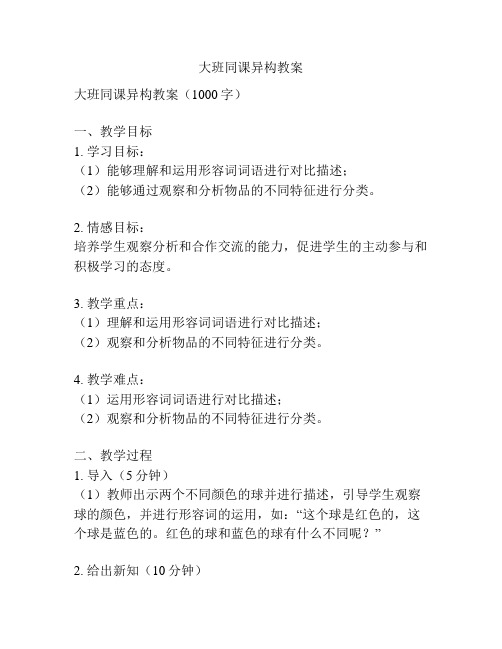
大班同课异构教案大班同课异构教案(1000字)一、教学目标1. 学习目标:(1)能够理解和运用形容词词语进行对比描述;(2)能够通过观察和分析物品的不同特征进行分类。
2. 情感目标:培养学生观察分析和合作交流的能力,促进学生的主动参与和积极学习的态度。
3. 教学重点:(1)理解和运用形容词词语进行对比描述;(2)观察和分析物品的不同特征进行分类。
4. 教学难点:(1)运用形容词词语进行对比描述;(2)观察和分析物品的不同特征进行分类。
二、教学过程1. 导入(5分钟)(1)教师出示两个不同颜色的球并进行描述,引导学生观察球的颜色,并进行形容词的运用,如:“这个球是红色的,这个球是蓝色的。
红色的球和蓝色的球有什么不同呢?”2. 给出新知(10分钟)(1)教师出示两个不同形状的球并进行描述,如:“这个球是圆形的,这个球是长条形的。
圆形的球和长条形的球有什么不同呢?”(2)教师引导学生运用形容词进行描述,如:“圆形的球和长条形的球是不同的,圆形的球是圆的,长条形的球是长的。
”(3)教师介绍形容词词语进行对比描述的方法,如:“我们可以用形容词词语来对比描述物品,比如大和小,高和矮,圆和方,红和绿等。
”(4)教师给出更多例子进行练习,引导学生熟练运用形容词进行对比描述。
3. 活动一(15分钟)(1)教师将课前准备的不同形状的物品分发给学生,每个学生手中都有两个不同形状的物品。
(2)教师让学生观察两个物品的不同特征,并用形容词进行对比描述,如:“这个物品是长的,那个物品是短的。
这个物品是方的,那个物品是圆的。
”(3)教师引导学生将这些物品根据形状进行分类,如:“请把长的物品放在一堆,把短的物品放在另一堆。
”(4)教师鼓励学生积极参与,引导他们进行合作交流,让学生互相观察和比较,然后给出答案。
4. 活动二(20分钟)(1)教师将课堂中的桌子、椅子等物品分为几组,每组准备2-3个相同的物品。
(2)教师提问学生:“这些物品有什么相同的特征呢?”引导学生观察和分析,如:“这些物品都是坚固的,都可以坐。
同课异构教学设计共3篇

同课异构教学设计共3篇同课异构教学设计共1“同课异构”教案《回收废品》教学设计裕丰园小学童彩红教学目标:1、学会用加减法解决一些简单的实际问题。
2、从小渗透环保知识,培养学生的环保意识。
3、体验数学与生活的紧密联系。
教具准备:教学挂图、投影仪、电脑课件。
教学重难点:重点:能正确列式并计算。
难点:理解“比多比少”的实际问题。
学具准备:小棒。
教学流程一、情境导入。
电脑课件出示图:公园里各个角落都有许多各式各样的塑料袋和塑料瓶。
师:这是教师今天特意去公园拍摄下的,你看到了什么?学生自由谈话,教师引导学生注意到塑料袋和塑料瓶。
师:这都是人们留下的,如果再这样下去我们美丽的公园将变成了什么样呀?1 学生想象,并发表简短的感受。
师:是呀,有三个小朋友也意识到了这个问题,所以他们决定一起来收集这些塑料袋和塑料瓶。
二、新课教学1、出示课件:师:请同学们认真观察图,一起来认识这三个小朋友。
生说出三个人的名字:小林、小红和小青。
师:他们好像正在讨论着什么事情,谁知道?请学生读出三人的对话。
找出数学信息:小林:收集26个塑料瓶小红:我收集的塑料瓶比小林多3个小青:我收集的塑料瓶比小林少4个2、提出问题:师:根据他们的对话,你能提出什么问题?生:小红收集了多少个塑料瓶?(1)学生摆小棒,小组交流讨论。
(2)集体交流反馈。
师:这个问题谁能解决?生:23+6=29(个)师:你是怎样想的,为什么用加法呢?生1:我是通过摆小棒知道的,小林有23个,我就先摆23根小棒,小红多了6个,我就再增加6。
23增加6可以用加法算式23+6来表2 示。
生2:小红说我收集的塑料袋比小林多6个,也就是说在小林23个的基础上再多加6。
师小结:原来要求比一个数多几的数就是用加法的,多了多少就加上多少。
师:刚才同学们说得真好,还可以提出什么问题呢?生:我可以提出,小青收集了多少个塑料袋?师:你能摆一摆小青收集的塑料袋的个数吗?3、学生动手摆,然后表示。
数学同课异构活动方案
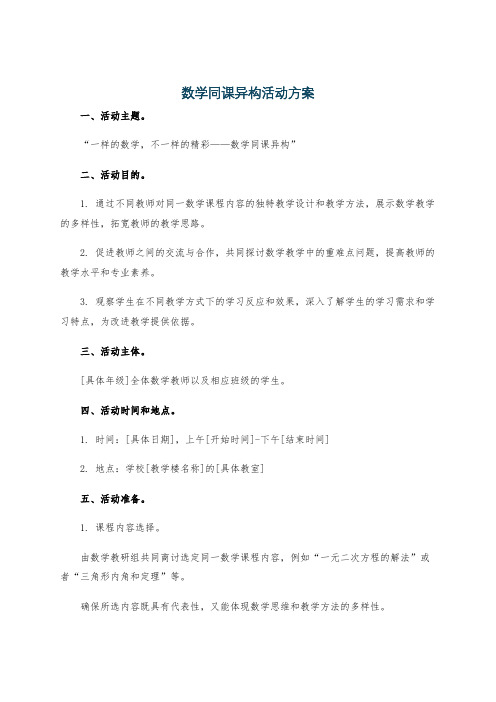
数学同课异构活动方案一、活动主题。
“一样的数学,不一样的精彩——数学同课异构”二、活动目的。
1. 通过不同教师对同一数学课程内容的独特教学设计和教学方法,展示数学教学的多样性,拓宽教师的教学思路。
2. 促进教师之间的交流与合作,共同探讨数学教学中的重难点问题,提高教师的教学水平和专业素养。
3. 观察学生在不同教学方式下的学习反应和效果,深入了解学生的学习需求和学习特点,为改进教学提供依据。
三、活动主体。
[具体年级]全体数学教师以及相应班级的学生。
四、活动时间和地点。
1. 时间:[具体日期],上午[开始时间]-下午[结束时间]2. 地点:学校[教学楼名称]的[具体教室]五、活动准备。
1. 课程内容选择。
由数学教研组共同商讨选定同一数学课程内容,例如“一元二次方程的解法”或者“三角形内角和定理”等。
确保所选内容既具有代表性,又能体现数学思维和教学方法的多样性。
2. 教师分组与准备。
根据教师的教龄、教学风格等因素将数学教师分成若干小组,每组[X]名教师。
提前[X]周告知教师活动主题、课程内容和活动要求,让教师们有充足的时间进行教学设计。
要求教师们在教学设计中明确教学目标、教学重难点、教学方法、教学过程(包括导入、新授、练习、总结等环节)以及预期的教学效果。
3. 教学资源准备。
各教师根据自己的教学设计准备相应的教学资源,如多媒体课件、教具(如几何模型、计数器等)、练习资料等。
确保教室的多媒体设备、投影仪、音响等教学设施正常运行。
4. 学生准备。
在活动前向学生介绍同课异构活动的大致情况,让学生了解活动的目的和意义,提高学生的参与积极性。
按照正常的教学进度安排学生预习活动当天要学习的课程内容。
六、活动流程。
1. 开场致辞(上午[具体时间] [具体时间])由学校领导或数学教研组长发表开场讲话,介绍本次同课异构活动的主题、目的、流程和要求,强调活动的重要性和积极意义。
2. 同课异构课堂教学展示(上午[具体时间] 下午[具体时间])按照预先安排的顺序,各小组教师依次进行课堂教学展示。
教研活动数学同课异构(3篇)

第1篇一、活动背景为了提升教师的教学水平,促进教师之间的交流与合作,我校开展了数学同课异构教研活动。
本次教研活动以“同课异构”为主题,旨在通过对比不同教师对同一课题的课堂教学,探讨教学策略,优化教学设计,提高教学质量。
二、活动目标1. 通过同课异构,促进教师之间的交流与合作,共同提高教学水平。
2. 探索不同教学策略,优化教学设计,提高课堂教学效果。
3. 培养学生的数学思维能力和创新能力。
三、活动内容本次教研活动以人教版小学数学四年级下册“分数的加减法”为课题,由两位教师进行同课异构。
四、活动过程1. 第一课时(1)教师A的课堂展示教师A以“生活中的分数”为切入点,引导学生观察生活中的分数现象,激发学生的学习兴趣。
接着,通过小组合作探究,让学生自主发现分数加减法的计算方法。
在课堂上,教师A注重学生的动手操作和合作交流,鼓励学生大胆表达自己的观点。
(2)教师B的课堂展示教师B以“分数加减法的计算”为主题,通过多媒体课件展示分数加减法的计算步骤,让学生直观地了解计算方法。
在课堂上,教师B注重学生的计算练习,通过设置不同难度的题目,让学生在练习中巩固所学知识。
2. 第二课时(1)教师A的课堂展示教师A以“分数加减法的应用”为切入点,通过解决实际问题,让学生体会分数加减法在生活中的应用。
在课堂上,教师A注重学生的思考和分析能力,鼓励学生提出自己的解题思路。
(2)教师B的课堂展示教师B以“分数加减法的拓展”为主题,引导学生探究分数加减法的性质,如交换律、结合律等。
在课堂上,教师B注重学生的探究能力,鼓励学生自主发现规律,提高学生的数学思维能力。
五、活动总结1. 两位教师在课堂教学中都注重学生的主体地位,通过创设情境、小组合作等方式,激发学生的学习兴趣,提高学生的参与度。
2. 教师A在课堂上注重学生的动手操作和合作交流,引导学生自主发现分数加减法的计算方法;教师B在课堂上注重学生的计算练习和探究能力,让学生在练习中巩固所学知识。
同课异构活动方案15篇优
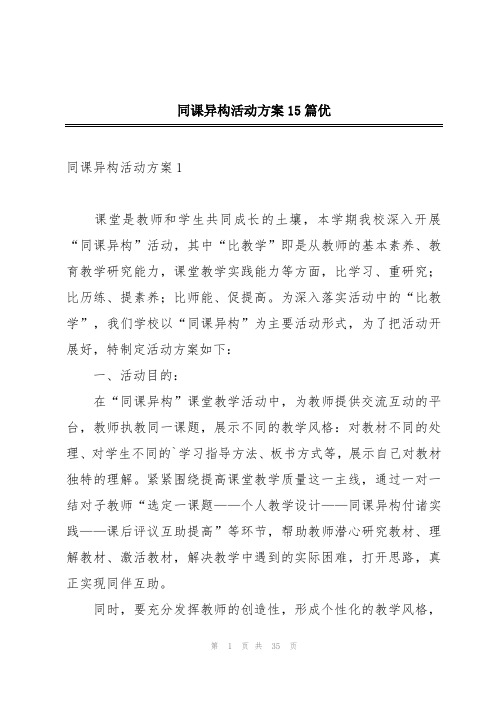
同课异构活动方案15篇优同课异构活动方案1课堂是教师和学生共同成长的土壤,本学期我校深入开展“同课异构”活动,其中“比教学”即是从教师的基本素养、教育教学研究能力,课堂教学实践能力等方面,比学习、重研究;比历练、提素养;比师能、促提高。
为深入落实活动中的“比教学”,我们学校以“同课异构”为主要活动形式,为了把活动开展好,特制定活动方案如下:一、活动目的:在“同课异构”课堂教学活动中,为教师提供交流互动的平台,教师执教同一课题,展示不同的教学风格:对教材不同的处理、对学生不同的`学习指导方法、板书方式等,展示自己对教材独特的理解。
紧紧围绕提高课堂教学质量这一主线,通过一对一结对子教师“选定一课题——个人教学设计——同课异构付诸实践——课后评议互助提高”等环节,帮助教师潜心研究教材、理解教材、激活教材,解决教学中遇到的实际困难,打开思路,真正实现同伴互助。
同时,要充分发挥教师的创造性,形成个性化的教学风格,促进教师专业成长。
二、活动步骤1、选定同一课题。
年级组根据教学计划和教学进度,与年级教师合作,选择同一课题。
2、个人教学设计。
教师研究教材,广泛收集资料,根据自己的教学风格和学生的特点设计切实可行的教学设计。
3、同课异构实践阶段。
以上课、听课、评课、议课形式进行。
4、课后评议。
课上完后,由教研组授课教师利用教研的形式进行集体评议和个体反思,对课的特点、不足,教师对教材解读、处理进行xx,促进教师教学能力的提高5、总结与反思。
这一环节由执教教师写教学反思或整理课堂实录,目的是让教师通过这次活动将自己的所思所感以文字的形式记录,固定下来,以促进教师的专业化成长。
三、参与形式1该年级组的所有教师都参与了研究,而其他年级组的教师则根据自己的班级调整了他们的参与。
2学科带头人和学校部分骨干教师努力参与到整个过程中。
四、活动时间:20xx年9月16日至20xx年9月27日五、具体安排:自本学期第四周9月16日开始。
教研组同课异构活动方案(3篇)
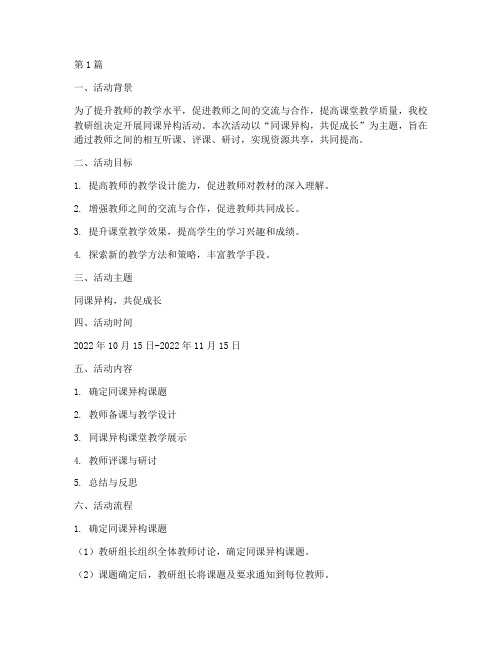
第1篇一、活动背景为了提升教师的教学水平,促进教师之间的交流与合作,提高课堂教学质量,我校教研组决定开展同课异构活动。
本次活动以“同课异构,共促成长”为主题,旨在通过教师之间的相互听课、评课、研讨,实现资源共享,共同提高。
二、活动目标1. 提高教师的教学设计能力,促进教师对教材的深入理解。
2. 增强教师之间的交流与合作,促进教师共同成长。
3. 提升课堂教学效果,提高学生的学习兴趣和成绩。
4. 探索新的教学方法和策略,丰富教学手段。
三、活动主题同课异构,共促成长四、活动时间2022年10月15日-2022年11月15日五、活动内容1. 确定同课异构课题2. 教师备课与教学设计3. 同课异构课堂教学展示4. 教师评课与研讨5. 总结与反思六、活动流程1. 确定同课异构课题(1)教研组长组织全体教师讨论,确定同课异构课题。
(2)课题确定后,教研组长将课题及要求通知到每位教师。
2. 教师备课与教学设计(1)教师根据课题要求,结合自身教学风格和班级特点,进行备课。
(2)教师完成教学设计,包括教学目标、教学重难点、教学方法、教学过程等。
3. 同课异构课堂教学展示(1)每位教师按照教学设计进行课堂教学展示。
(2)其他教师进行听课,并做好记录。
4. 教师评课与研讨(1)课后,听课教师对授课教师的教学进行评价,并提出改进意见。
(2)教研组长组织教师进行研讨,共同探讨教学中的问题及解决办法。
5. 总结与反思(1)教研组长对本次活动进行总结,肯定成绩,指出不足。
(2)教师针对自己在教学中的问题进行反思,制定改进措施。
七、活动要求1. 全体教师积极参与,认真备课、听课、评课、研讨。
2. 教师在备课过程中,要深入理解教材,创新教学设计。
3. 课堂教学展示要注重实效,提高教学质量。
4. 教师在评课、研讨过程中,要本着客观、公正、诚恳的态度,提出有针对性的意见和建议。
八、活动保障1. 学校领导高度重视,为活动提供必要的支持和保障。
同课异构教研活动案例(3篇)

第1篇一、活动背景为了进一步提升教师的教学水平和专业素养,我校决定开展同课异构教研活动。
通过选取同一课题,不同教师进行教学展示,以此激发教师的创新思维,促进教师之间的交流与合作,共同探讨教学中的难点和困惑,从而提高教学质量。
二、活动主题本次教研活动的主题为“小学语文《草原》一课的同课异构”。
三、活动时间2023年3月15日四、活动地点小学语文教研组活动室五、参与人员小学语文教研组全体教师六、活动流程1. 课前准备- 教研组提前确定课题《草原》。
- 教师分组,每组选派一名代表进行备课和教学设计。
- 每位教师根据自身教学风格和班级特点,设计不同的教学方案。
2. 教学展示- 每位教师按照自己的教学设计进行课堂展示。
- 教师展示结束后,其他教师进行观摩和记录。
3. 课后研讨- 教师们集中进行研讨,针对每位教师的教学展示,从教学目标、教学方法、课堂效果等方面进行评价和交流。
- 分组讨论,针对教学中的难点和困惑进行深入探讨,提出改进措施。
4. 总结反思- 教研组长对本次活动进行总结,提出改进建议。
- 教师们撰写个人反思,总结经验教训。
七、活动内容1. 教学展示教师A的教学设计以学生自主探究为主,通过小组合作、讨论等方式,引导学生深入理解课文内容,培养学生的合作意识和自主学习能力。
教师B的教学设计则侧重于朗读教学,通过多种形式的朗读活动,帮助学生感受草原的美丽景色和作者的情感。
教师C的教学设计则以多媒体辅助教学,通过图片、视频等手段,直观地展示草原的壮丽景色,激发学生的学习兴趣。
2. 课后研讨在课后研讨环节,教师们针对三位教师的教学展示进行了热烈的讨论。
- 教师A的教学设计得到了大家的一致好评,认为其能够充分调动学生的学习积极性,培养学生的合作意识。
- 教师B的朗读教学设计也得到了认可,认为其能够帮助学生更好地理解课文内容,体会作者的情感。
- 教师C的多媒体辅助教学设计也受到了肯定,认为其能够直观地展示教学内容,提高学生的学习兴趣。
语文教研活动同课异构(3篇)
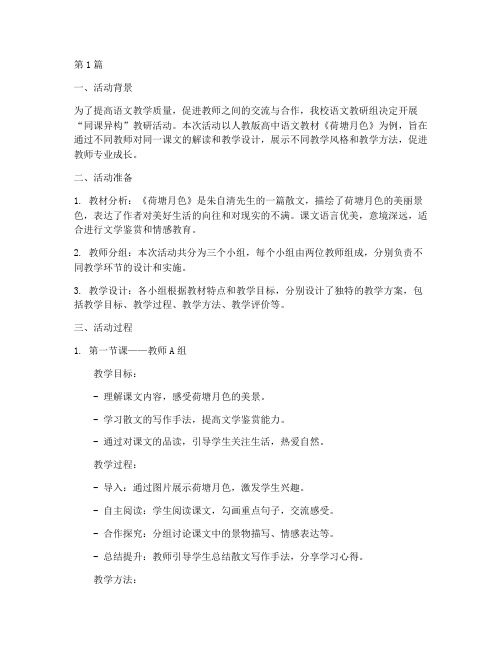
第1篇一、活动背景为了提高语文教学质量,促进教师之间的交流与合作,我校语文教研组决定开展“同课异构”教研活动。
本次活动以人教版高中语文教材《荷塘月色》为例,旨在通过不同教师对同一课文的解读和教学设计,展示不同教学风格和教学方法,促进教师专业成长。
二、活动准备1. 教材分析:《荷塘月色》是朱自清先生的一篇散文,描绘了荷塘月色的美丽景色,表达了作者对美好生活的向往和对现实的不满。
课文语言优美,意境深远,适合进行文学鉴赏和情感教育。
2. 教师分组:本次活动共分为三个小组,每个小组由两位教师组成,分别负责不同教学环节的设计和实施。
3. 教学设计:各小组根据教材特点和教学目标,分别设计了独特的教学方案,包括教学目标、教学过程、教学方法、教学评价等。
三、活动过程1. 第一节课——教师A组教学目标:- 理解课文内容,感受荷塘月色的美景。
- 学习散文的写作手法,提高文学鉴赏能力。
- 通过对课文的品读,引导学生关注生活,热爱自然。
教学过程:- 导入:通过图片展示荷塘月色,激发学生兴趣。
- 自主阅读:学生阅读课文,勾画重点句子,交流感受。
- 合作探究:分组讨论课文中的景物描写、情感表达等。
- 总结提升:教师引导学生总结散文写作手法,分享学习心得。
教学方法:- 图片展示- 自主阅读- 小组合作- 讲授法、讨论法2. 第二节课——教师B组教学目标:- 理解课文内容,体会作者的情感。
- 学习散文的抒情手法,提高写作能力。
- 通过对课文的朗读,培养学生的审美情趣。
教学过程:- 导入:播放荷塘月色相关的音乐,营造氛围。
- 朗读课文:学生齐读课文,感受作者的抒情手法。
- 情感体验:教师引导学生体会作者的情感,分享个人感受。
- 写作实践:学生根据课文内容,进行仿写练习。
教学方法:- 音乐导入- 朗读课文- 情感体验- 讲授法、仿写法3. 第三节课——教师C组教学目标:- 理解课文内容,把握散文的结构特点。
- 学习散文的修辞手法,提高文学鉴赏能力。
“同课异构”教研活动实施方案
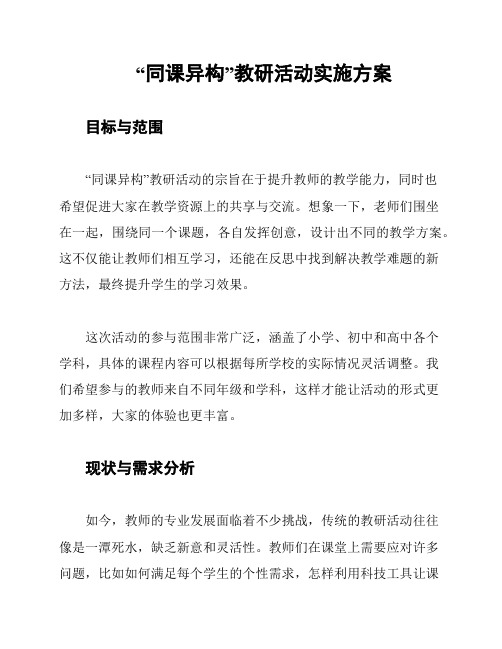
“同课异构”教研活动实施方案目标与范围“同课异构”教研活动的宗旨在于提升教师的教学能力,同时也希望促进大家在教学资源上的共享与交流。
想象一下,老师们围坐在一起,围绕同一个课题,各自发挥创意,设计出不同的教学方案。
这不仅能让教师们相互学习,还能在反思中找到解决教学难题的新方法,最终提升学生的学习效果。
这次活动的参与范围非常广泛,涵盖了小学、初中和高中各个学科,具体的课程内容可以根据每所学校的实际情况灵活调整。
我们希望参与的教师来自不同年级和学科,这样才能让活动的形式更加多样,大家的体验也更丰富。
现状与需求分析如今,教师的专业发展面临着不少挑战,传统的教研活动往往像是一潭死水,缺乏新意和灵活性。
教师们在课堂上需要应对许多问题,比如如何满足每个学生的个性需求,怎样利用科技工具让课堂更加活跃。
开展“同课异构”教研活动,能够给这些问题一个积极的回应,帮助大家形成一个学习共同体。
而且,教师们对专业发展的渴望也在不断增强,他们希望能有更多的机会去学习和交流。
根据对500名教师的问卷调查,差不多80%的教师想通过教研活动提升自己的教学技能,40%的教师希望能探索一些更具创意的教学方法。
因此,开展这样的活动绝对是个值得尝试的好主意。
实施步骤与操作指南选题与准备在每个学期开始时,各校可以组织一次全校范围的选题会议,让教师们根据自己的经验和学生的需求,提出想要探讨的课题。
在选题时,我们可以考虑以下几点:- 课题的相关性:要和当前的教学内容紧密相连。
- 课题的可操作性:确保教师在教学中能够实际运用。
- 课题的创新性:鼓励大家尝试新的教学方法和手段。
确定课题后,可以组建专门的备课小组,教师们可以根据各自的特长与经验,进行分组研究与设计。
教学展示每个学期,可以安排一次全校范围的教学展示活动。
参与的教师们围绕同一课题,展现不同的教学设计和授课方式。
活动的形式可以包括:- 面对面授课:老师们在课堂上实际授课,学生们积极参与。
- 录像展示:提前录制好的授课视频,在教研活动中播放,便于讨论。
初中英语同课异构教案

初中英语同课异构教案一、第一章:同课异构的基本概念与原则1.1 同课异构的定义解释同课异构的概念,即在教学内容、教学目标、教学方法和教学评价等方面,对同一课程内容进行多种不同的设计和组织。
强调同课异构的目的在于激发学生的学习兴趣,提高教学效果。
1.2 同课异构的原则教学目标明确性原则:确保每种同课异构设计都能够达到明确的教学目标。
学生参与性原则:鼓励学生积极参与同课异构活动,提高他们的主动学习能力。
教学方法多样性原则:运用多种教学方法,如讲解、讨论、小组合作等,丰富教学过程。
二、第二章:同课异构的教学设计2.1 确定教学目标根据课程标准和学生需求,明确教学目标。
确保每种同课异构设计都能够达到教学目标的要求。
2.2 选择教学内容根据教学目标和学生的实际情况,选择适合的同课异构内容。
注意内容的难易程度和与学生生活经验的关联性。
三、第三章:同课异构的教学方法与策略3.1 讲解法通过讲解来传授知识,引导学生理解和思考。
运用生动的语言、举例和图表等辅助教学。
3.2 讨论法组织学生进行小组讨论,促进学生之间的交流与合作。
提供问题或话题,引导学生发表自己的观点和思考。
四、第四章:同课异构的教学评价与反思4.1 教学评价设计合理的评价标准和评价方法,对学生的学习成果进行评价。
采用多种评价方式,如考试、作业、表现评价等。
4.2 教学反思在同课异构教学过程中,及时进行教学反思。
分析教学效果和学生反馈,调整教学方法和策略。
五、第五章:同课异构案例分享5.1 案例一:阅读理解教学设计不同难度的阅读材料,满足不同学生的需求。
运用讲解法、讨论法和任务型教学法等多种教学方法。
5.2 案例二:口语表达教学设计不同形式的口语表达活动,如角色扮演、小组讨论等。
鼓励学生积极参与,提高口语表达能力和交流能力。
六、第六章:同课异构教学实践案例分析6.1 案例分析一:词汇教学设计不同难度的词汇练习,满足不同学生的学习需求。
运用游戏、竞赛和情境教学法等多种教学方法,增强词汇学习的趣味性。
教研活动计划同课异构(3篇)

第1篇一、活动背景为了进一步提升教师的教学水平,促进教师之间的交流与合作,本教研活动计划以“同课异构”的形式开展。
通过不同教师对同一教学内容的不同解读和教学设计,探讨不同教学策略和方法,以促进教师专业成长和教学质量的提高。
二、活动主题同课异构——基于核心素养的教学设计与实施三、活动目标1. 通过同课异构,促进教师对同一教学内容的不同理解,丰富教学思路。
2. 提高教师对教材的解读能力和教学设计的创新能力。
3. 加强教师之间的交流与合作,共同探讨有效的教学策略。
4. 提升学生的核心素养,促进学生的全面发展。
四、活动时间2023年10月15日(星期日)上午8:00-12:00五、活动地点XX学校多功能厅六、参与人员1. 学校全体语文教师2. 邀请相关学科专家进行指导七、活动流程1. 准备阶段(2023年9月15日-9月30日)a. 确定同课异构的教材内容,如《义务教育语文课程标准》中规定的某篇课文。
b. 分组讨论,确定各小组的教学设计思路和教学目标。
c. 各组教师进行教学设计,包括教学环节、教学方法、教学资源等。
2. 实施阶段(2023年10月15日)a. 第一节课:由第一位教师按照自己的教学设计进行授课。
b. 第二节课:由第二位教师按照自己的教学设计进行授课。
c. 第三节课:由第三位教师按照自己的教学设计进行授课。
3. 研讨阶段(2023年10月15日-10月20日)a. 各组教师对三节课进行评课,交流教学心得。
b. 专家对教学活动进行点评,提出改进建议。
c. 教师根据专家意见和同伴反馈,修改和完善自己的教学设计。
4. 总结阶段(2023年10月21日)a. 各组教师总结活动收获,撰写活动反思。
b. 学校对本次活动进行总结,表彰优秀个人和团队。
八、活动内容1. 教学设计展示各组教师展示自己的教学设计,包括教学目标、教学重难点、教学过程、教学评价等。
2. 课堂教学展示三位教师分别进行课堂教学展示,每位教师授课时间为40分钟。
“同课异构”教学活动实施方案

“同课异构”教学活动实施方案一、背景介绍“同课异构”是一种在教育领域中常见的教学模式,旨在满足不同学生的研究需求,提高教学效果。
该模式要求教师在相同的教学内容基础上,根据学生的差异使用不同的教学方法和教学资源。
二、目标及目的实施“同课异构”的教学活动的目标是提高教学的个性化和差异化水平,满足学生的研究需求,培养学生的综合能力。
具体目的包括:1. 根据学生的不同研究能力和兴趣,提供个性化的研究体验。
2. 增强学生的自主研究能力和问题解决能力。
3. 促进学生之间的合作研究和交流。
三、实施步骤为了确保“同课异构”的教学活动顺利进行,我们建议以下实施步骤:1. 分析学生群体:了解学生的不同特点、研究能力、兴趣爱好等,为个性化教学提供依据。
2. 制定教学计划:根据教学内容、学生需求和教学目标,制定相应的教学计划。
3. 选择教学方法和教学资源:基于学生的差异,选择适合不同学生的教学方法和教学资源,如教学技术、教学媒体、教材等。
4. 设计研究活动:针对不同学生的需求,设计相应的研究活动,包括小组合作、个人研究、实验实践等。
5. 实施教学活动:按照教学计划和设计的研究活动,进行具体的教学实施。
6. 评估和反馈:通过教学反馈和学生评估,及时调整教学方案,改进个性化教学效果。
四、风险和挑战在实施“同课异构”的教学活动中,可能会面临以下风险和挑战:1. 教学资源不足:个性化教学需要充足的教学资源支持,而某些资源可能有限或不足够。
2. 学生接受度差异:不同学生对于“同课异构”教学活动的接受度有所不同,需要适度引导和激发学生的积极性。
3. 教学管理复杂:个性化教学需要对学生进行分类管理和跟踪,增加了教师的工作量和教学管理难度。
五、评估方法为了评估“同课异构”教学活动的效果,我们建议使用以下评估方法:1. 学生表现评估:通过观察学生的研究表现、成绩、作品等,评估学生在个性化教学中的研究效果。
2. 学生反馈调查:收集学生对于“同课异构”教学活动的反馈意见和建议,了解他们的研究体验和满意度。
同课异构教案

同课异构教案### 同课异构教案#### 课程名称:《同课异构》#### 教学目标:1. 让学生理解“同课异构”的概念,即同一课程内容通过不同的教学方法和结构来实现教学目标。
2. 培养学生的创新思维和教学设计能力。
3. 通过实际案例分析,让学生掌握如何根据不同学生特点设计教学方案。
#### 教学内容:1. “同课异构”的定义和意义。
2. 不同教学方法的介绍和比较。
3. 教学设计的基本步骤。
4. 案例分析:同一课程内容的不同教学设计。
#### 教学方法:1. 讲授法:对“同课异构”的概念进行讲解。
2. 讨论法:学生分组讨论不同教学方法的优劣。
3. 案例分析法:通过具体案例,分析不同教学设计的效果。
4. 角色扮演法:学生模拟教师,设计自己的教学方案。
#### 教学过程:导入新课(5分钟)- 通过提问的方式引入“同课异构”的概念,让学生思考为什么同一课程内容需要不同的教学设计。
讲授新课(15分钟)- 讲解“同课异构”的定义,解释其在教学中的重要性。
- 介绍几种常见的教学方法,如讲授法、讨论法、案例教学法等,并比较它们的优缺点。
分组讨论(15分钟)- 学生分成小组,讨论不同教学方法在实际教学中的应用,以及如何根据学生特点选择合适的教学方法。
案例分析(20分钟)- 提供几个同一课程内容但不同教学设计的实际案例,让学生分析每种设计的优势和可能存在的问题。
- 引导学生思考如何改进这些教学设计,使其更适合特定的学生群体。
角色扮演(20分钟)- 学生扮演教师角色,根据所学内容设计一个“同课异构”的教学方案。
- 每个小组展示自己的教学设计,并由其他小组提出建议和评价。
课堂总结(5分钟)- 总结“同课异构”的重要性和实施方法。
- 强调创新在教学设计中的价值,鼓励学生在今后的教学实践中尝试不同的教学方法。
#### 作业布置:- 要求学生设计一个“同课异构”的教学方案,针对不同的学生群体,并在下节课上进行分享和讨论。
通过这样的教案设计,学生不仅能够理解“同课异构”的概念,还能够在实际操作中锻炼自己的教学设计能力,为将来的教学实践打下坚实的基础。
同课异构教学设计
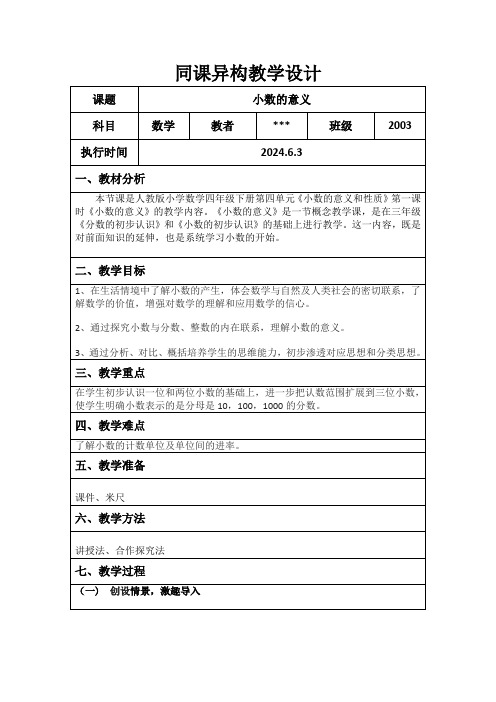
同课异构教学设计量一量:请同学们动手量一量课桌的边长,说说长、宽分别是多少米?学生动手量,教师巡视观察。
提问:你的桌子边长是整米数吗?学生讨论发言。
小结:大多数同学的桌子边长都不是整米数,长和宽都不够1米,像这种情况该如何表示呢?下面我们先来一起分析一下米尺好吗?教师谈话:同学们,学生在日常购物、测量的过程中常常不能用整数来表示这时我们就用到了小数。
板书课题:小数的意义(二)新授师:在日常生活中,除了商品标价不够整元可以用小数外。
在量屋子的高度时,它不够整米时,以米作单位也常用小数表示。
1、教学小数的意义。
(1)教学一位小数蒙层把刚才的题目稍作更改:(出示米尺)把一条长1米的线段平均分成10份,这样1份是米,用小数表示是()米。
超级分类板书: 1分米 3分米 7分米0.1米 0.3米 0.7米小结:把1米平均分成10份,这样的一份或几份的数可以用一位小数表示,写在小数点右面的第一位,表示十分之几。
小练:如果8分米呢?以米为单位,怎么写成分数和小数?9分米呢?(2)教学两位小数课件出示主题图引导学生观察。
把刚才的题目再做更改:(出示放大的1分米)题目和上面哪里不一样?答案一样吗?把一条长1米的线段平均分成100份,这样1份是米,用小数表示是()米。
表格遮罩板书: 1cm 4cm 8cm小结:把1米平均分成100份,这样的一份或几份的数可以用两位小数表示,写在小数点右面的第二位,表示百分之几。
音频小练:如果28厘米呢?以米为单位怎么写成分数和小数?70厘米呢?(3)教学三位小数把一条长1米的线段平均分成1000份,这样1份是米,用小数表示是()米。
小练:256毫米呢?999毫米呢?指名学生出题,全班化成分数和小数。
(4)师:我们还可以照前面的方法继续分下去,可以得到四位、五位......小数。
启发学生根据前面3个问题的研究,可以得出什么结论? (把1米平均分成10份,1份或几份可以用一位小数表示,分成100份,1份或几份可以用两位小数表示,分成1000份,1份或几份可以用三位小数表示......)2、小结:像上面这些分数也可以依照整数的写法来写,写在整数个位的右面,用圆点隔开,用来表示十分之几、百分之几、千分之几的数,叫做小数。
共课异构教研活动方案(3篇)
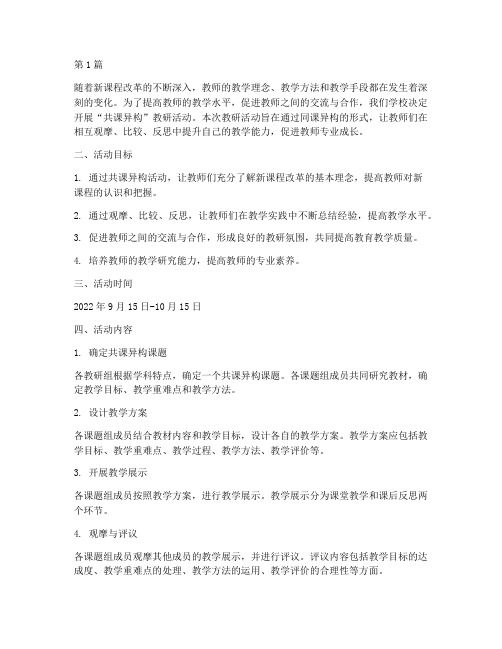
第1篇随着新课程改革的不断深入,教师的教学理念、教学方法和教学手段都在发生着深刻的变化。
为了提高教师的教学水平,促进教师之间的交流与合作,我们学校决定开展“共课异构”教研活动。
本次教研活动旨在通过同课异构的形式,让教师们在相互观摩、比较、反思中提升自己的教学能力,促进教师专业成长。
二、活动目标1. 通过共课异构活动,让教师们充分了解新课程改革的基本理念,提高教师对新课程的认识和把握。
2. 通过观摩、比较、反思,让教师们在教学实践中不断总结经验,提高教学水平。
3. 促进教师之间的交流与合作,形成良好的教研氛围,共同提高教育教学质量。
4. 培养教师的教学研究能力,提高教师的专业素养。
三、活动时间2022年9月15日-10月15日四、活动内容1. 确定共课异构课题各教研组根据学科特点,确定一个共课异构课题。
各课题组成员共同研究教材,确定教学目标、教学重难点和教学方法。
2. 设计教学方案各课题组成员结合教材内容和教学目标,设计各自的教学方案。
教学方案应包括教学目标、教学重难点、教学过程、教学方法、教学评价等。
3. 开展教学展示各课题组成员按照教学方案,进行教学展示。
教学展示分为课堂教学和课后反思两个环节。
4. 观摩与评议各课题组成员观摩其他成员的教学展示,并进行评议。
评议内容包括教学目标的达成度、教学重难点的处理、教学方法的运用、教学评价的合理性等方面。
5. 总结与反思各课题组成员针对教学展示和评议环节,进行总结与反思,提出改进措施。
五、活动安排1. 第1周:各教研组确定共课异构课题,设计教学方案。
2. 第2周:各课题组成员进行教学展示,其他成员观摩。
3. 第3周:各课题组成员进行评议,总结与反思。
4. 第4周:各课题组成员撰写教学反思,提交教研组。
六、活动要求1. 各教研组要高度重视本次共课异构教研活动,确保活动顺利进行。
2. 各课题组成员要积极参与活动,认真备课、上课、评议和反思。
3. 教研组长要负责组织本组活动,确保活动质量。
同课异构活动方案

同课异构活动方案目标和范围同课异构活动的核心目的是通过多样化的教学手段和学习方式,来提升学生的综合素养和能力,激发他们的学习热情。
这种活动特别适合初中和高中生,能够在知识、能力和情感等多方面促进他们的全面发展。
具体来说,方案涵盖课程设计、教学方法创新和评估方式的多样化等多个维度。
组织现状与需求分析在当今的教育环境中,很多老师仍然固守传统的教学模式,强调知识的灌输,却忽视了学生自主学习和探索的能力。
这种情况导致学生的学习兴趣逐渐减弱,学习效果也不尽如人意。
通过对学校的访谈和问卷调查,发现学生们普遍希望能在课堂上有更多的互动和不同的学习体验,而教师们也渴望通过多样化的教学方式来提升课堂氛围。
具体实施步骤课程内容设计设计课程内容时,应该考虑与学生生活的实际联系,吸引他们的注意力。
可以从以下几个角度出发:- 结合时下热门话题如环境保护、科技创新,设计相关课程。
- 引入项目式学习,鼓励学生围绕某个主题进行小组讨论、研究和展示。
- 开发跨学科的课程,打破学科壁垒,让学生从多个视角理解问题。
教学方法创新创新教学方法是同课异构活动的关键,可以尝试:- 互动式教学:通过小组讨论、角色扮演等方式,让学生积极参与课堂。
- 探究式学习:鼓励学生自主提出问题,进行独立或小组研究,培养他们的批判性思维。
- 翻转课堂:把知识传授的重心放在课外,课堂上则进行更多讨论和实践活动。
评估方式多样化评估不仅仅是检测知识,更要关注学生能力与情感的发展。
可以采用:- 形成性评估:通过课堂表现和作业完成情况进行定期评估,及时反馈。
- 同伴评估:鼓励学生互相评价,学习彼此的优点,增强团队合作精神。
- 自我评估:让学生反思自己的学习过程,设定个人目标,增强自我管理能力。
操作指南为了确保活动顺利进行,需要一个详细的操作指南。
活动准备- 教师培训:组织教师进行相关培训,教授新的教学方法和评估方式。
- 资源准备:准备教材、教具和其他学习资源,比如视频和书籍等。
开展同课异构式教研活动(3篇)
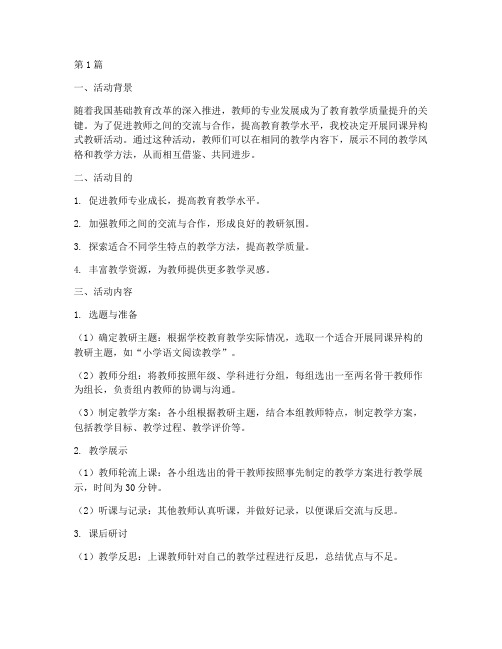
第1篇一、活动背景随着我国基础教育改革的深入推进,教师的专业发展成为了教育教学质量提升的关键。
为了促进教师之间的交流与合作,提高教育教学水平,我校决定开展同课异构式教研活动。
通过这种活动,教师们可以在相同的教学内容下,展示不同的教学风格和教学方法,从而相互借鉴、共同进步。
二、活动目的1. 促进教师专业成长,提高教育教学水平。
2. 加强教师之间的交流与合作,形成良好的教研氛围。
3. 探索适合不同学生特点的教学方法,提高教学质量。
4. 丰富教学资源,为教师提供更多教学灵感。
三、活动内容1. 选题与准备(1)确定教研主题:根据学校教育教学实际情况,选取一个适合开展同课异构的教研主题,如“小学语文阅读教学”。
(2)教师分组:将教师按照年级、学科进行分组,每组选出一至两名骨干教师作为组长,负责组内教师的协调与沟通。
(3)制定教学方案:各小组根据教研主题,结合本组教师特点,制定教学方案,包括教学目标、教学过程、教学评价等。
2. 教学展示(1)教师轮流上课:各小组选出的骨干教师按照事先制定的教学方案进行教学展示,时间为30分钟。
(2)听课与记录:其他教师认真听课,并做好记录,以便课后交流与反思。
3. 课后研讨(1)教学反思:上课教师针对自己的教学过程进行反思,总结优点与不足。
(2)互动交流:各小组教师针对教学展示进行互动交流,分享教学心得,提出改进意见。
(3)总结与提升:教研组长对本次活动进行总结,提出针对性的改进措施,为今后的教学提供借鉴。
四、活动实施1. 时间安排:活动时间为一个学期,每周开展一次,每次活动时间为2小时。
2. 参与对象:全校教师均可参与,特别是青年教师和新教师,要积极参与,通过活动提高自己的教学水平。
3. 考核评价:学校对参与活动的教师进行考核评价,将活动参与情况纳入教师年度考核。
五、预期效果1. 教师的专业素养得到提高,教育教学水平得到提升。
2. 教师之间的交流与合作更加紧密,形成良好的教研氛围。
同课异构教学设计方案

二、教学目标1. 知识目标:通过同课异构的教学方式,使学生了解不同教学方法的优缺点,提高学生的课堂参与度和学习效果。
2. 能力目标:培养学生分析、比较、总结的能力,提高学生的创新思维和团队协作能力。
3. 情感目标:激发学生的学习兴趣,培养学生的自主学习意识,增强学生的自信心。
三、教学重难点1. 重点:掌握同课异构的教学方法,提高课堂教学效果。
2. 难点:如何根据不同学生的特点,灵活运用同课异构的教学方法。
四、教学过程(一)导入1. 教师通过PPT展示不同教学方法的优缺点,引导学生思考如何提高课堂教学效果。
2. 学生分组讨论,总结出同课异构教学的优势。
(二)课堂展示1. 教师选取同一课题,分别采用不同的教学方法进行课堂展示。
2. 学生观察、记录教师的教学过程,分析不同教学方法的优缺点。
(三)小组讨论1. 学生分组讨论,总结出同课异构教学方法的实际应用。
2. 各小组汇报讨论成果,教师点评、总结。
(四)实践操作1. 教师布置课后作业,要求学生根据所学知识,设计一节同课异构的课堂。
2. 学生完成课后作业,教师进行点评、指导。
(五)总结与反思1. 教师总结本节课的教学内容,强调同课异构教学的重要性。
2. 学生分享自己的学习心得,反思自己在课堂上的表现。
五、教学评价1. 学生课堂参与度:观察学生在课堂上的表现,评价学生的课堂参与度。
2. 学生学习效果:通过课后作业和小组讨论,评价学生的学习效果。
3. 教师教学水平:观察教师的教学方法、课堂管理等方面,评价教师的教学水平。
六、教学反思1. 教师在课堂教学中,应注重培养学生的创新思维和团队协作能力。
2. 教师要善于运用同课异构的教学方法,提高课堂教学效果。
3. 教师要关注学生的学习需求,及时调整教学策略,提高教学质量。
同课异构高中优秀教案模板

一、教学目标1. 知识目标:- 学生能够掌握本节课的核心知识点,如……- 学生能够理解……概念、原理、方法等。
2. 能力目标:- 学生能够运用所学知识解决实际问题,如…… - 学生能够通过……活动提高……能力。
3. 情感目标:- 学生能够培养对……的兴趣和热爱。
- 学生能够树立正确的……观念。
二、教学重难点1. 重点:- 本节课的教学重点在于……- 学生需要熟练掌握……内容。
2. 难点:- 本节课的教学难点在于……- 教师需要引导学生突破……难点。
三、教学过程(一)导入1. 情境导入:通过……情境,激发学生的学习兴趣。
2. 问题导入:提出……问题,引导学生思考。
3. 复习导入:复习……知识点,为新课学习做铺垫。
(二)新课讲授1. 环节一:讲解- 教师讲解……知识点,结合……案例,帮助学生理解。
- 学生边听边记,做好笔记。
2. 环节二:活动- 学生分组进行……活动,如……- 教师巡回指导,解答学生疑问。
3. 环节三:讨论- 学生就……问题进行讨论,分享自己的观点。
- 教师引导学生总结,提炼出……结论。
(三)巩固练习1. 课堂练习:完成……练习题,巩固所学知识。
2. 课后作业:布置……作业,巩固所学知识。
(四)课堂小结1. 回顾:回顾本节课所学内容,总结……知识点。
2. 反思:反思自己的学习过程,找出……不足。
四、同课异构教学设计1. 教学思路:- 采用……教学思路,如……- 注重启发式教学,引导学生主动学习。
2. 教学方法:- 采用……教学方法,如……- 结合多媒体教学,提高教学效果。
3. 教学评价:- 关注学生的学习过程,注重……评价。
- 采用……评价方式,如……- 及时反馈,帮助学生改进学习方法。
五、教学反思1. 教学效果:- 分析本节课的教学效果,总结……经验。
- 找出……不足,为今后的教学提供借鉴。
2. 改进措施:- 针对……不足,提出……改进措施。
- 不断优化教学设计,提高教学质量。
六、教学资源1. 教材:……教材2. 教具:……教具3. 多媒体:……多媒体资源七、教学时间1. 总课时:……课时2. 每节课时:……课时八、备注1. 本教案仅供参考,教师可根据实际情况进行调整。
同课异构教研活动方案
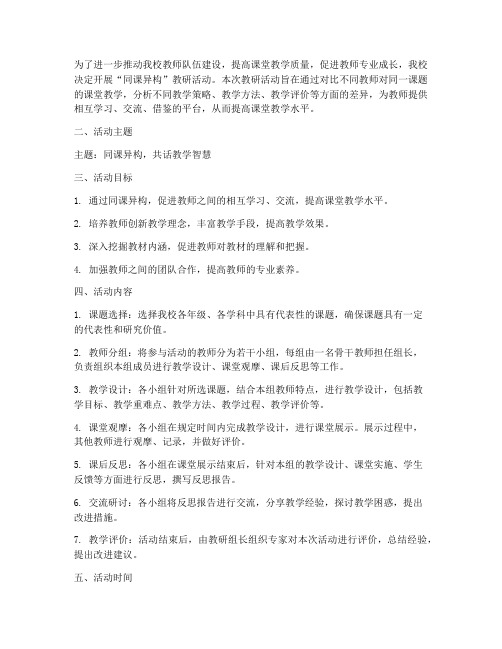
为了进一步推动我校教师队伍建设,提高课堂教学质量,促进教师专业成长,我校决定开展“同课异构”教研活动。
本次教研活动旨在通过对比不同教师对同一课题的课堂教学,分析不同教学策略、教学方法、教学评价等方面的差异,为教师提供相互学习、交流、借鉴的平台,从而提高课堂教学水平。
二、活动主题主题:同课异构,共话教学智慧三、活动目标1. 通过同课异构,促进教师之间的相互学习、交流,提高课堂教学水平。
2. 培养教师创新教学理念,丰富教学手段,提高教学效果。
3. 深入挖掘教材内涵,促进教师对教材的理解和把握。
4. 加强教师之间的团队合作,提高教师的专业素养。
四、活动内容1. 课题选择:选择我校各年级、各学科中具有代表性的课题,确保课题具有一定的代表性和研究价值。
2. 教师分组:将参与活动的教师分为若干小组,每组由一名骨干教师担任组长,负责组织本组成员进行教学设计、课堂观摩、课后反思等工作。
3. 教学设计:各小组针对所选课题,结合本组教师特点,进行教学设计,包括教学目标、教学重难点、教学方法、教学过程、教学评价等。
4. 课堂观摩:各小组在规定时间内完成教学设计,进行课堂展示。
展示过程中,其他教师进行观摩、记录,并做好评价。
5. 课后反思:各小组在课堂展示结束后,针对本组的教学设计、课堂实施、学生反馈等方面进行反思,撰写反思报告。
6. 交流研讨:各小组将反思报告进行交流,分享教学经验,探讨教学困惑,提出改进措施。
7. 教学评价:活动结束后,由教研组长组织专家对本次活动进行评价,总结经验,提出改进建议。
五、活动时间1. 教学设计阶段:1周2. 课堂展示阶段:1周3. 课后反思阶段:1周4. 交流研讨阶段:1周5. 教学评价阶段:1周六、活动组织1. 成立活动领导小组,负责活动的组织、协调和监督。
2. 明确各阶段工作职责,确保活动顺利进行。
3. 邀请校内外专家、骨干教师参与活动,提供专业指导。
4. 加强与教师、学生的沟通,了解活动效果,及时调整活动方案。
- 1、下载文档前请自行甄别文档内容的完整性,平台不提供额外的编辑、内容补充、找答案等附加服务。
- 2、"仅部分预览"的文档,不可在线预览部分如存在完整性等问题,可反馈申请退款(可完整预览的文档不适用该条件!)。
- 3、如文档侵犯您的权益,请联系客服反馈,我们会尽快为您处理(人工客服工作时间:9:00-18:30)。
同课异构教学案:Unit 2 Topic 1 You’d better go to see a doctor
Section A
铜仁五中:杨霞Ⅰ.Learning aims and demands
1. Learn some new words and phrases:
toothache, dentist, have a cold, cough, take a rest, fever, flu, headache, at night, coffee, tea, plenty, plenty of, boiled water, lift
2. Learn some useful sentences:
(1)I have a toothache.
(2)I’m sorry to hear that.
(3)I have a bad cold.
3. Learn the modals for giving advice:
(1)You should see a dentist.
(2)You shouldn’t drink coffee or tea in the evening.
4. Talk about illnesses.
5. Learn to express sympathy for a patient and give some advice to the patients. Ⅱ.Teaching difficulties:
1、Students may find it difficult to remember all the target new words in the class
2、Students may find it difficult to give appropriate advice to the certain disease because of their limited life experience.
Ⅲ. Teaching aids
图片.录音机.卡片
IV.Teaching procedure:
1.课前预习课本
2.自读课本,找出新词,新句型。
3.课前准备:
(1)翻译。
1.等一会,稍等______________
2.接电话______________________
3.洗澡_______________
4.打扫卫生_____________________
5.听收音机______________
6.玩电脑游戏___________________
7.练习作某事______________ 8.看电视__________________
(2)句型。
I was calling you at this time yesterday.
变否定句:__________________________________
变一般疑问句:_______________________________
作肯、否定回答:_________________________________
对划线部分提问:____________________________________
Step 1 Review
1.Warm up:Daily dialogs.
2.Show the title and the teaching aims.
3.Read the new words and phrases,and teach students how to learn the text by
themself.
4. Learn the text by students themselves.
Step 2 Presentation
1.Listen to the tape ,answer the following question.
3.(教师根据学生情况处理重难点。
)The following may be used.
Useful expressions
1)What's wrong with sb.?=What's the matter with sb?某人怎么了?
2)I’m sorry to hear that.听到此事我很难过。
3)I hope you’ll get well soon.希望你很快康复。
4)look well /get well 系动词+adj. Well作为形容词,只能表示身体健康的。
5)表达病情:sb. + have/has+病种.
have a toothache have a backache have a stomachache
have a headache have a cold have a fever
have a cough have the flu have sore eyes
6)用shoud/shouldn't表达建议
Example1: A: What’s wrong with you ?
B: I have a bad cold .
A: I’m sorry to hear that . You should see a doctor ...
B: Thank you .I think I will .
Example2: A: What’s the matter with you ?
B: I have a backache.
A: I’m sorry to hear that . You shouldn't lift heavy things.
B: Thank you . I won't .
Step 3 Consolidation
1.Pair work. 用表格里的信息,模仿1a对话操练, 完成1b.
2.Ask and answer questions according to the pictures in 1c.
A:What's wrong/the matter with he/ she?
B:He / She has...
A:What should he / she do?
B: He /She should ...
Step 4 Practice
1. Work alone.Ask Ss to read 2 and match. (进入2练习。
)
T: Finish 2 in a minute, come on!
(教师核对答案。
)
Lead Ss to summarise and master the usage of "should/ shouldn't", and other language points in this section.
2.Ask Ss to fill in the blanks and finish the conversation.(核对答案。
)
3.If time permits, finish Part 3.
T:Then please listen to the conversations in 3 and number the following pictures. Then write down the advice. (核对答案。
)
Step 5 Homework
1.
2.
Example1: A: What’s wron g with you ?
B: I have a bad cold .
A: I’m sorry to hear that . You should see a doctor ...
B: Thank you .I think I will .
Example2:A: What’s the matter with you ?
B: I have a backache.
A: I’m sorry to hear that . You shouldn't lift heavy things.
B: Thank you . I won't .
把两人一组操练过的对话写在作业本上,明日上交。
2. Finish workbook.。
